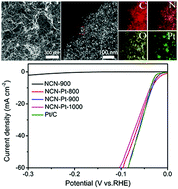In situ synthesis of small Pt nanoparticles on chitin aerogel derived N doped ultra-thin carbon nanofibers for superior hydrogen evolution catalysis†
Abstract
Nitrogen-doped carbon nanofibers (NCNs) derived from chitin with an ultrafine nanofiber network structure (5–10 nm) showed a large specific surface area (426 m2 g−1). Small and uniform platinum nanoparticles (Pt NPs) were in situ synthesized on the chitin aerogel derived N doped ultra-thin carbon nanofibers (NCN-Pt) by combining adsorbing, freeze–drying and pyrolysis processes. The increased carbonization temperature from 800 to 1000 °C leads to a change of Pt NP average diameter from 2.85 ± 0.1 nm to 4.5± 0.1 nm. The unique three-dimensional mesoporous ultra-thin nanofiber network can protect the Pt NPs from aggregation, enabling resulting abundant active sites. NCN-Pt-900 exhibits enhanced HER activity with an overpotential of 34 mV and a Tafel slope of 39 mV decade−1 in comparison with commercial Pt/C (36 mV and 35 mV decade−1). Significantly, NCN-Pt-900 has excellent stability and durability for the HER. There were no obvious changes in LSV curves after 5000 cycles. Chitin is one of the most abundant natural polymers and is mainly derived from marine biomass. The synthesis strategy described herein is simple and scalable and it opens a new avenue to fabricate metal NPs on chitin aerogel derived N doped ultra-thin carbon nanofibers.



 Please wait while we load your content...
Please wait while we load your content...